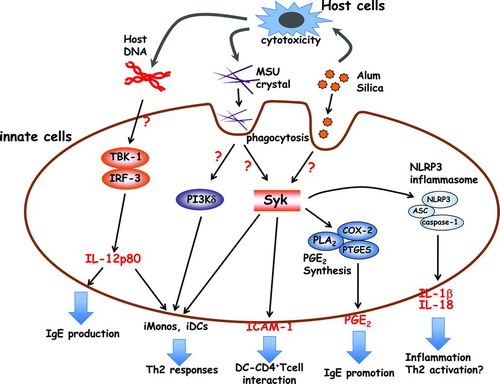Figures & data
FIGURE 1. Proposed mechanisms of particulate adjuvants (alum, MSU, silica) in innate immunity. Alum induces cell death, and the damaged host cells, such as macrophages and neutrophils, release genomic DNA and uric acid as DAMPs. The recognition mechanisms of genomic DNA are still unclear, but the TBK-1-IRF3 axis plays an important part in IgE production and iMono/iDC migration via the IL-12p80 production. The released uric acid forms MSU crystals, which are recognized by lipid sorting on DCs. The engulfed MSU crystals trigger the activation of Syk and PI3Kδ, and induce inflammatory cells or a strong interaction between DCs and CD4+ T cells. However, the released uric acid has not been shown to form crystals at the site of alum injection. Alum and silica stimulate macrophages and DCs to produce NLRP3 inflammasome-dependent IL-1β and IL-18. These cytokines contribute (at least in part) to acute inflammation and Th2 activation. Macrophages and DCs also induce PGE2 in response to alum and silica via Syk activation. PGE2 is involved in IgE production. iMonos: inflammatory monocytes; iDCs: inflammatory DCs.

TABLE 1. Summary of the effect of particulate (alum) adjuvant on immune system